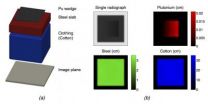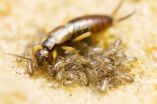The key to easy asthma diagnosis is in the blood
2014-04-15
MADISON, Wis. — Using just a single drop of blood, a team of University of Wisconsin-Madison researchers has developed a faster, cheaper and more accurate tool for diagnosing even mild cases of asthma.
This handheld technology — which takes advantage of a previously unknown correlation between asthmatic patients and the most abundant type of white blood cells in the body — means doctors could diagnose asthma even if their patients are not experiencing symptoms during their visit to the clinic.
The team described its findings in the journal Proceedings of the National ...
Girls' mental health suffers when romances unfold differently than they imagined
2014-04-15
WASHINGTON, DC, April 15, 2014 — A new study reveals that for adolescent girls, having a romantic relationship play out differently than they imagined it would has negative implications for their mental health.
"I found that girls' risk of severe depression, thoughts of suicide, and suicide attempt increase the more their relationships diverge from what they imagined," said the study's author Brian Soller, an assistant professor of sociology and a senior fellow of the Robert Wood Johnson Foundation Center for Health Policy at the University of New Mexico.
"Conversely, ...
Genetic pre-disposition toward exercise and mental development may be linked
2014-04-15
COLUMBIA, Mo. – University of Missouri researchers have previously shown that a genetic pre-disposition to be more or less motivated to exercise exists. In a new study, Frank Booth, a professor in the MU College of Veterinary Medicine, has found a potential link between the genetic pre-disposition for high levels of exercise motivation and the speed at which mental maturation occurs.
For his study, Booth selectively bred rats that exhibited traits of either extreme activity or extreme laziness. Booth then put the rats in cages with running wheels and measured how much ...
How mothers help children explore right and wrong
2014-04-15
Montreal, April 15, 2014 — There's no question that mothers want their children to grow up to be good people — but less is known about how they actually help their offspring sort out different types of moral issues.
According to a new study published in Developmental Psychology and led by Holly Recchia, assistant professor in Concordia's Department of Education and the Centre for Research in Human Development, many mums talk to their kids in ways that help them understand moral missteps.
The study — co-written by Cecilia Wainryb, Stacia Bourne and Monisha Pasupathi ...
Biologists develop nanosensors to visualize movements and distribution of plant hormone
2014-04-15
Biologists at UC San Diego have succeeded in visualizing the movement within plants of a key hormone responsible for growth and resistance to drought. The achievement will allow researchers to conduct further studies to determine how the hormone helps plants respond to drought and other environmental stresses driven by the continuing increase in the atmosphere's carbon dioxide, or CO2, concentration.
A paper describing their achievement appears in the April 15 issue of the scientific journal eLife and is accessible at: http://elife.elifesciences.org/lookup/doi/10.7554/elife.01739 ...
Pharmacist-led interventions show high success rates for post-stroke care
2014-04-15
A new study from the Faculty of Medicine & Dentistry is looking at nurse- and pharmacist-led interventions to improve the standard of care for patients who have suffered minor stroke or transient ischemic attack, also known as "mini stoke."
"What we were finding was that six months or 12 months after their stroke, a lot of patients still had uncontrolled blood pressure and uncontrolled cholesterol," said Finlay McAlister (MD '90), lead author of the study. "[This factor] puts the patients at an increased risk of recurrent events, including strokes, heart attacks, amputation ...
Photo: Tiger beetle's chase highlights mechanical law
2014-04-15
ITHACA, N.Y. – If an insect drew a line as it chased its next meal, the resulting pattern would be a tangled mess. But there's method to that mess, says Jane Wang, a Cornell University professor of mechanical engineering and physics, who tries to find simple physical explanations for complex, hardwired animal behaviors.
Photo: https://cornell.box.com/tbeetle
It turns out the tiger beetle, known for its speed and agility, does an optimal reorientation dance as it chases its prey at blinding speeds. Publishing online April 9 in the Journal of the Royal Society Interface, ...
Researchers transplant regenerated esophagus
2014-04-15
Tissue engineering has been used to construct natural oesophagi, which in combination with bone marrow stem cells have been safely and effectively transplanted in rats. The study, published in Nature Communications, shows that the transplanted organs remain patent and display regeneration of nerves, muscles, epithelial cells and blood vessels.
The new method has been developed by researchers at Karolinska Institutet in Sweden, within an international collaboration lead by Professor Paolo Macchiarini. The technique to grow human tissues and organs, so called tissue engineering, ...
Sensitive detection method may help impede illicit nuclear trafficking
2014-04-15
WASHINGTON D.C., April 15, 2014 -- According to the International Atomic Energy Agency (IAEA) the greatest danger to nuclear security comes from terrorists acquiring sufficient quantities of plutonium or highly enriched uranium (HEU) to construct a crude nuclear explosive device. The IAEA also notes that most cases of illicit nuclear trafficking have involved gram-level quantities, which can be challenging to detect with most inspection methods.
According to a new study appearing this week in the Journal of Applied Physics, coupling commercially available spectral X-ray ...
New study from Harvard identifies transgender health disparities
2014-04-15
New Rochelle, NY, April 15, 2014—Transgender individuals are medically underserved and their healthcare needs incompletely understood in part because they represent a subpopulation whose health is rarely monitored by U.S. national surveillance systems. To address these issues, a new study compared methods of collecting and analyzing data to assess health disparities in a clinical sample of transgender individuals, as reported in an article published in LGBT Health, a peer-reviewed journal from Mary Ann Liebert, Inc., publishers. The article is available free on the LGBT ...
Targeting cancer with a triple threat
2014-04-15
CAMBRIDGE, MA -- Delivering chemotherapy drugs in nanoparticle form could help reduce side effects by targeting the drugs directly to the tumors. In recent years, scientists have developed nanoparticles that deliver one or two chemotherapy drugs, but it has been difficult to design particles that can carry any more than that in a precise ratio.
Now MIT chemists have devised a new way to build such nanoparticles, making it much easier to include three or more different drugs. In a paper published in the Journal of the American Chemical Society, the researchers showed ...
Online reviews: When do negative opinions boost sales?
2014-04-15
When purchasing items online, reading customer reviews is a convenient way to get a real-world account of other people's opinions of the product. According to a new study in the Journal of Consumer Research, negative reviews that are offset by a politeness-factor can actually help sell the item.
"Most of the research on consumer reviews has been on the content and volume of the message," write authors Ryan Hamilton (Emory University), Kathleen D. Vohs (University of Minnesota), and Ann L. McGill (University of Chicago Booth School of Business). "Our research looks at ...
Hair from infants gives clues about their life in the womb
2014-04-15
MADISON – Like rings of a tree, hair can reveal a lot of information about the past.
It can tell if a person recently used drugs or an athlete was doping. It can provide information about hormones and expose environmental toxins.
And, as a team of University of Wisconsin-Madison researchers show in a study of rhesus monkeys, published in the April 2014 edition of the journal Pediatric Research, it can also reveal the womb environment in which an infant formed.
It's the first time researchers have used infant hair to examine the hormonal environment to which the fetus ...
Unexpected protein partnership has implications for cancer treatment
2014-04-15
Scientists have identified two unlikely partners, in a type of immune cell called a macrophage, that work together, in response to cancer drugs, to increase inflammation in a way that may alter tumor growth. Researchers from the National Institutes of Health published the study in the journal Cancer Research.
These partners are the p53 protein that suppresses tumors and the nuclear factor-kappaB (NF-kappaB) protein that stimulates their growth. Blocking this partnership could help prevent inflammation from occurring in cancer patients undergoing chemotherapy.
"Since ...
New method of screening children for autism spectrum disorders works at 9 months old
2014-04-15
Washington, DC – Researchers, including a team from Children's National Health System, have identified head circumference and head tilting reflex as two reliable biomarkers in the identification of autism spectrum disorders (ASD) in children that are between 9 and 12 months of age.
According to the U.S. Centers for Disease Control and Prevention, ASD is identifiable as early as two years old, although most children are not identified until after the age of four. While a number of studies have reported that parents of children with ASD notice developmental problems in ...
Low-calorie restaurant menus: Are they making us fat?
2014-04-15
Depending on our food cravings, the number of items served, and even the time of day, ordering a meal at a restaurant often requires a "narrowing down" decision making process. According to a new study in the Journal of Consumer Research, restaurants that now provide "low-calorie" labels on their menus can inadvertently cause people to eliminate healthy foods right off the bat.
"Because most restaurant menus are quite complex—offering numerous dishes composed of multiple ingredients—diners try to simplify their decision. People have come to expect low-calorie food to ...
More should be done for female parolees
2014-04-15
EAST LANSING, Mich. --- As the female prison population grows, a new study funded partly by the National Science Foundation says more should be done to help women probationers and parolees in poor urban areas remain crime-free.
A team of Michigan State University criminologists found black women on probation and parole feel they have little choice but to isolate themselves in their homes or risk getting caught up in the type of criminal activity that got them in trouble in the first place.
Probation and parole officers, case managers and others should help the women ...
When identity marketing backfires: Consumers don't like to be told what they like
2014-04-15
When choosy moms choose Jif peanut butter and sports fans who call themselves sports fans subscribe to DirecTV, identity marketing is hard at work. But what happens when this type of advertising misses the mark? According to a new study in the Journal of Consumer Research, when a person's sense of ownership and freedom is threatened they are less likely to respond positively to identity marketing campaigns.
"While people may be drawn to brands that fit their identity, they are also more likely to desire a sense of ownership and freedom in how they express that identity. ...
Sibling cooperation in earwig families gives clues to early evolution of social behavior
2014-04-15
Looking at the question of how social behavior has developed over the course of evolution, scientists from the universities in Mainz and Basel have gained new insights from the study of earwigs. "Young earwig offspring don't simply compete for food. Rather the siblings share what is available amongst themselves, especially when the mother is absent," explained Dr. Joël Meunier of the Evolutionary Biology section of the Institute of Zoology at Johannes Gutenberg University of Mainz (JGU). The team of biologists from Mainz University and the University of Basel investigated ...
Charitable donation discrepancies: Why are some countries more generous than others?
2014-04-15
When it comes to charitable giving, some countries open their collective wallets more than others. According to a new study in the Journal of Consumer Research, people who live in countries that promote equality in power and wealth are more likely to donate money than those who live in societies that expect and accept inequality.
"Our research examines whether cultural values can explain the different levels of charitable giving between different countries," write authors Karen Page Winterich (Pennsylvania State University) and Yinlong Zhang (University of Texas, San ...
Chew on this: How does food texture impact its perceived calorie content?
2014-04-15
Food is an intimately personal thing; we savor some tastes and despise others. But how does the way we chew and eat our food impact our overall consumption? According to a new study in the Journal of Consumer Research, people perceive foods that are either hard or have a rough texture to have fewer calories.
"We studied the link between how a food feels in your mouth and the amount we eat, the types of food we choose, and how many calories we think we are consuming," write authors Dipayan Biswas, Courtney Szocs (both University of South Florida), Aradhna Krishna (University ...
Consumer predictions: Do categories matter when predicting the lottery or stock market?
2014-04-15
From sports to the stock market and even winning the lottery, it's in our nature to predict who or what will come out on top. But, sometimes we can't see the forest for the trees. According to a new study in the Journal of Consumer Research, people are more likely to make a prediction about something when it is grouped in a large category of similar items.
"One factor that can contribute to a person's flawed judgment is categorization," write authors Mathew S. Isaac (Seattle University) and Aaron R. Brough (Utah State University). "When making a prediction, we can become ...
Can refined categorization improve prediction of patient survival in RECIST 1.1
2014-04-15
In a recent analysis by the RECIST Working Group published in the European Journal of Cancer, EORTC researchers had explored whether a more refined categorization of tumor response or various aspects of progression could improve prediction of overall survival in the RECIST database. They found that modeling target lesion tumor growth did not improve the prediction of overall survival above and beyond that of the other components of progression. The RECIST Working Group includes the EORTC, the United States National Cancer Institute, and the National Cancer Institute of ...
New method isolates immune cells for researchers to study how they ward off oral diseases
2014-04-15
Case Western Reserve University dental researchers have found a less invasive way to extract single rare immune cells from the mouth to study how the mouth's natural defenses ward off infection and inflammation.
By isolating some specialized immune cells (white blood cells known as "leukocytes") to study how they fight diseases in the mouth—or reject foreign tissues, such as in failed organ transplants—researchers hope to learn more about treating and preventing such health issues as oral cancers, cardiovascular disease, AIDS and other infectious diseases.
To this point, ...
Study: Deforestation could intensify climate change in Congo Basin by half
2014-04-15
By 2050, deforestation could cause temperatures in the Congo Basin to increase by 0.7 °C. The increase would intensify warming caused by greenhouse gases by half, according to a study by researchers at the University of Leuven, Belgium.
Explosive population growth and inefficient agricultural practices are causing large-scale destruction of tropical rainforests in Central Africa. A team of researchers from the University of Leuven examined how these practices will affect longer-term temperatures in the region. Using a sophisticated computer model, they forecasted Congo ...
[1] ... [3571]
[3572]
[3573]
[3574]
[3575]
[3576]
[3577]
[3578]
3579
[3580]
[3581]
[3582]
[3583]
[3584]
[3585]
[3586]
[3587]
... [8688]
Press-News.org - Free Press Release Distribution service.





